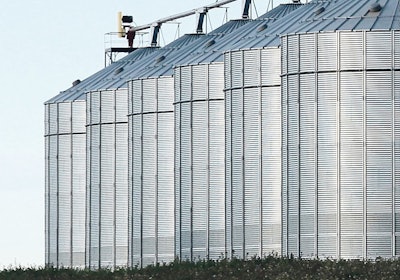
Cold winter temperatures keep mold and insect activity low in stored grain. Rising spring temperatures can trigger spoiling of grain that is wet or low quality. The allowable storage time that grain can be safely stored can be estimated using charts foundhere.

Check grain condition by looking for hot spots with temperature cable sensing systems or with a portable temperature probe. Turn on the aeration fan and check the first flush of air that comes from the grain. A musty smell indicates early stages of mold activity, while a sour smell indicates serious trouble.
A handheld carbon dioxide (CO2) monitor can give an earlier and more accurate indication of quality problems. When CO2levels coming off the grain are 600 parts per million (ppm) and rising, aeration with cool air should be used to reduce grain temperature. Act quickly to remove grain when CO2levels rise above 1,500 ppm.
Any grain that was stored wetter than the recommended moisture contents, above 15% for corn and 13% for soybeans, should be dried or moved when cool grain temperatures (30-40 degrees Fahrenheit) can no longer be maintained. Grain stored cool through the winter does not need to be warmed up in the spring. Instead, aerate grain to maintain cool and even temperatures in the bin. Run aeration fans to check grain or run aeration cycles for temperature control during cool weather rather than warm, sunny days.
When cooling grain, keep the fan on long enough for a complete aeration cycle.
The grain mass is not fully cooled until the aeration cycle is complete, meaning that the temperature front moves all the way from the bottom to the top of the grain with a fan pushing air up through the bin. An airflow rate of at least 0.1 cfm per bushel is required for successful aeration.
Use theUniversity of Minnesota fan selection program, found atbbefans.cfans.umn.edu, to estimate the airflow rate per bushel based on your fan, grain bin size, and grain depth. An aeration fan with 0.1 cfm per bushel will take around 150 hours to fully cool the grain, while a larger drying fan with 1 cfm per bushel will take around 15 hours.
This spring and summer:
- Check grain frequently to monitor for signs of spoilage, such as crusting, damp/warm spots, musty or sour odors, or rising CO2levels
- Seal fans when not being used to prevent warm air from entering the grain through the floor
- Ventilate the headspace between the roof and the grain to minimize grain surface warming
Spoiled grain is often connected to incidents of grain entrapments and fatalities.
Use extra caution around grain bins when grain spoilage is suspected. Before entering any grain bin, be sure to follow safety recommendations, such as: turn off and lock out/tag out any unloading equipment, have a partner observing you, use a safety harness, and always be sure a crust hasn’t formed (an inverted cone on the grain surface should be present after grain has been unloaded).
Additional Resources:




















